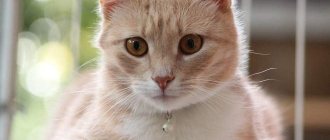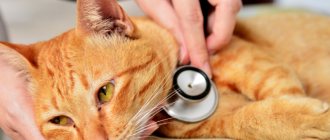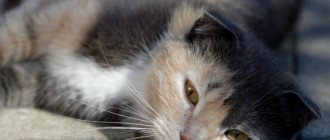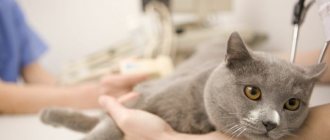We have repeatedly seen that our pets are susceptible to various kinds of diseases, no less than we humans. And we never tire of repeating that timely treatment not only helps to cope with the disease with little effort, but also significantly reduces pain in your pet cat. In this article, specialists from the Murkosha shelter analyzed in detail the symptoms and treatment of bronchitis in cats - a fairly common disease that, if treated improperly and untimely, can cause complications and even lead to death.
1) What is bronchitis and why does it occur 2) Symptoms of bronchitis in a cat 3) Modern methods of treating bronchitis in a cat 4) Prevention of bronchitis
What is feline bronchitis and what should it not be confused with?
The disease is accompanied by inflammation of the bronchial mucosa and copious secretion of fluid that accumulates in the lung tissue. As a result of irritation of the respiratory tract, the patient develops a cough and shortness of breath.
Advanced inflammation becomes chronic. The damaged mucosa becomes maximally vulnerable to microbes, and muscle fibers are gradually replaced by connective tissue. The bronchi lose their elasticity and cannot cope with their functions (cleansing, humidifying and warming the air).
The resulting symptoms are similar to the following pathologies:
- pulmonary parasitosis;
- pneumonia;
- diseases of the cardiovascular system and pleural cavity;
- bronchial asthma and allergies;
- foreign object stuck in the upper respiratory tract.
For this reason, before starting treatment, it is necessary to ensure that the intended diagnosis is correct. To do this you will have to go to a veterinary clinic.
Diagnosis and treatment
The sooner you contact your veterinarian, the sooner he will make an accurate diagnosis and prescribe treatment for bronchitis for your pet.
Diagnostics . A veterinarian in Moscow collects anamnesis, prescribes a general examination of blood, urine and sputum, and, if necessary, a general X-ray examination of the chest organs. You, as the owner, need to tell the doctor about the conditions in which your pet is kept, its feeding regime and signs of the disease - what symptoms are observed and for how long. The veterinarian needs all this in order, on the one hand, to differentiate bronchitis from bronchial asthma, tuberculosis and chronic pneumonia, and on the other, to prescribe effective treatment for your pet.
Treatment . It is aimed at eliminating factors that provoke bronchitis (for example, an allergen or helminthic infestation) and restoring the animal’s body. For this purpose, various drugs are prescribed, including broad-spectrum antibiotics and agents that dissolve inflammatory exudate and enhance its removal from the cat’s bronchi. Only according to indications, a veterinarian in Moscow prescribes anthelmintic drugs, glucocorticoids, and immunomodulators. They are necessary to eliminate the symptoms of the disease, as well as prevent possible complications (for example, bronchial asthma).
Home care . To speed up your animal's recovery, carefully follow all your veterinarian's recommendations and provide good home care for your pet. Remove possible irritants or allergens (for example, air fresheners), make sure that there are no drafts in the room where the cat lives, and provide her with a comfortable and warm place to rest - at least during the period of treatment and recovery. Pay special attention to your diet. Make sure your cat always has water at room temperature available. Consult your veterinarian regarding food.
Forecast
The prognosis for acute bronchitis is favorable. Almost all cases of the disease end in complete recovery if the cat owner promptly contacted a veterinary clinic in Moscow and followed all the doctor’s recommendations.
Unfortunately, with chronic bronchitis, a cautious prognosis is most often given. The fact is that with this form of the disease, irreversible damage to the bronchi often occurs. In this case, one of the goals of treating the animal is to slow or stop the progression of the disease.
On a note! Only a veterinarian can give an accurate prognosis after diagnosis - make an appointment at the veterinary clinic to find out how and with what to treat a pet suffering from bronchitis.
Causes of the disease
Based on their origin, possible causes of bronchitis in cats are divided into infectious and non-infectious. In the first case, for treatment it is necessary to destroy the pathogen, and in the second - to eliminate the provoking factor.
Infectious type
The causative agents of the infectious form are bacteria, viruses, fungi and lung helminths. Most often, inflammation of the bronchi occurs as a complication of rhinotracheitis, parainfluenza, adenovirus and toxocariasis.
Non-infectious type
There is no age-related predisposition to the disease. An inflammatory process in the mucous membranes can occur in both a kitten and an adult animal.
The main causes of non-infectious types include:
- Weakening of the immune system
. The body's defenses can be affected by hypothermia, prolonged stress or vitamin deficiency.
- Allergies
. Allergens can be medications, pollen, dust, tobacco smoke, and household chemicals. Frequent exposure to a smoky room is fraught with the appearance of a chronic form.
- Cardiovascular pathologies
. Heart problems are most common in older cats suffering from congestion in the pulmonary circulation.
Eliminating the provoking factor is important not only for recovery, but also for preventing relapses. Otherwise, the pet will have to be treated again.
Symptoms of the disease
The mechanism of the origin and development of bronchitis begins with the fact that any factor irritating the bronchi affects the receptors of the mucous membranes of the small nasopharynx of pets. As a result, small vessels begin to contract, the mucosal epithelium begins to dry, and the body begins to produce exudate containing:
- fibrin;
- epithelium;
- blood clots;
- microorganisms.
As a result, an inflammatory process occurs, which leads to swelling of the mucous membranes in the bronchi, and the lumen in them decreases. With further development of the process, a disruption of gas exchange processes in the cat’s body occurs.
Bronchitis in cats is always accompanied by a cough - this is one of the first symptoms of the onset of the disease. At the beginning of the disease, the cough may be dry. When a large amount of exudate accumulates in the bronchi, the cough can become wet and painful.
The main signs of an incipient disease include the following:
- sputum production after the cough has changed from dry to wet;
- rapid breathing: in a healthy individual, the number of inhalations and exhalations per minute is no more than 30, and after the onset of the disease, the number of respiratory movements can increase to 70;
- the appearance of shortness of breath. Due to the fact that breathing is difficult, the exchange of gases in the cat’s respiratory system is disrupted. To increase the flow of oxygen, the animal begins to stretch its head and neck upward, and spread its front legs wider, which helps improve ventilation of the lungs;
- mucous membranes become bluish in color;
- body temperature rises as pathogens begin to develop in the body;
- the eyes begin to water, and mucus may flow from the nose;
- during severe coughing, cats may begin to vomit;
- the sick animal is inactive, apathetic most of the time, sleeps a lot;
- The cat eats less or completely loses its appetite.
In chronic bronchitis, the clinical picture of the disease is blurred, so the disease can go undetected for a long time. Coughing attacks are rare and can begin after swimming, a stressful situation, or severe hypothermia. If bronchitis is advanced, then wheezing and gurgling can be observed in the chest. The temperature usually does not rise. The symptoms and treatment of chronic bronchitis in cats are slightly different from the acute form of the disease. Symptoms of this disease can last about 60 days.
Types of bronchitis in cats
Based on the nature of the course and the severity of the symptoms, the disease is divided into 2 forms: acute and chronic. Also separately distinguished is the asthmatic type, which occurs as a result of an allergic reaction.
Spicy
At the slightest irritation of the bronchi, the cat develops a dry cough. Most often it appears when inhaling cold air. In the first days, the attacks are short-term, but then their duration increases sharply.
Pain and the discharge of thick exudate from the nasal sinuses add to the symptoms. Mucous discharge quickly becomes purulent. Possible fever and vomiting.
The maximum duration of the acute form is 2-3 weeks. After the specified time, it becomes chronic.
Chronic
Chronic bronchitis often occurs in older cats and animals suffering from heart pathologies. It develops as a result of complications of the acute form, with collapse of the trachea or prolonged interaction with allergens.
The chronic form is characterized by a latent course. Despite this, rare coughing attacks do not stop even after 2 months. Without treatment, this form of the disease is often accompanied by complications, including oxygen deprivation.
Asthmatic
It develops as a result of a reaction to the regular entry of an allergen into the body and often occurs in a chronic form. Without timely treatment, it can develop into bronchial asthma, fraught with blockage of the airways.
Restoring the sense of smell
If you have a long-term loss of smell, you should immediately go to the clinic for an appointment with an otolaryngologist. If you treat yourself, you can worsen the current condition.
Recovery can be:
- Surgical.
Such intervention may be required in advanced cases (for example, with a tumor or deviated septum). Then the surgeon performs the operation.
- Medicinal.
The doctor prescribes a list of necessary medications, from nasal rinses to antibiotics, antiviral and antifungal agents.
- Physiotherapeutic.
Treatment may require physical therapy. The doctor prescribes heating or inhalation, and in some cases laser treatment is performed.
- People's
No one has abolished traditional medicine, but in no case should you prescribe decoctions for yourself. The doctor may prescribe a decoction for rinsing the nose from chamomile and oak bark or nasal drops based on aloe juice.
- Complex.
Those. This is the application of all types from physical therapy to surgical.
Symptoms of bronchitis in cats
The main sign of the pathology is a dry cough, which turns into a wet cough as mucus accumulates in the bronchi. The attacks are accompanied by stretching of the neck towards the floor, as if regurgitating hairballs. As their frequency and duration increase, the sick pet loses activity and appetite. Over time, the clinical picture becomes complicated by increasingly alarming symptoms:
- increased breathing and the appearance of wheezing;
- shortness of breath, accompanied by involuntary opening of the mouth in an attempt to swallow more oxygen;
- blueness of mucous membranes;
- pain during coughing, which is easily recognized by a plaintive meow;
- discharge from the sinuses and eyes;
- temperature increase;
- attacks of vomiting with bloody discharge;
- loss of consciousness.
If you notice at least one of the listed symptoms, be sure to contact your veterinarian. Otherwise, the pet may die from complications.
How to diagnose
To exclude similar pathologies and understand the physical condition of the lungs of a sick cat, the chest is listened to and tapped. Basic tests used in diagnosing diseases of the respiratory system include:
- a blood test showing an increase in white blood cells and neutrophils if the result is positive;
- stool analysis necessary to identify helminths;
- analysis of sputum and bronchial washings, identifying the type of pathogen in the case of an infectious cause;
- X-ray in frontal and lateral projections, assessing the degree of damage to the lung tissue.
When confirming the diagnosis and determining the cause of the disease, the veterinarian selects drugs to destroy the pathogen and relieve the symptoms that arise. If there is no threat to life, treatment is carried out at home.
Diagnostic measures
If owners suspect that their cat has developed bronchitis, it is important to contact a medical facility as quickly as possible. First of all, the veterinarian will conduct a survey, during which he will find out how long ago the unwanted symptoms developed. Then the doctor begins to examine and listen to the chest. To confirm the preliminary diagnosis, the pet is sent for the following examinations:
To confirm his suspicions, the doctor may refer the pet for bronchoscopy.
- general and biochemical blood tests;
- bronchial lavage;
- stool analysis;
- X-ray of the sternum;
- bronchoscopy.
Since pathologies of the respiratory system have similar symptoms, it is important to distinguish bronchitis from other ailments.
Treatment of bronchitis in cats
First of all, it is recommended to place the patient in a warm room, protected from drafts. During treatment, he should be protected from stress and ensure complete rest, reducing contact with noisy children and other pets.
If the cat is used to going outside, then access to the outside will have to be temporarily limited. Exceptions cannot be made even in the warm season.
If you identify an allergy, try to completely eliminate contact with allergens or reduce their amount. This will help with wet cleaning, stopping smoking in the presence of your pet and placing hazardous substances out of the reach of furry paws.
Food should be easily digestible and satisfying. When serving the food, make sure it is no higher or lower than room temperature. Decoctions of sage, linden, coltsfoot, chamomile and plantain will ease the removal of phlegm. Before using these herbs, be sure to make sure there is no allergy by smearing a small area of skin with the prepared product.
Drug therapy
A considerable part of the drugs will have to be purchased at a human pharmacy. Trying to calculate the dosage yourself can seriously harm your pet, so listen to your veterinarian's recommendations.
Depending on the condition of the body, the form and cause of the disease, the following drugs may be required for treatment:
- mucolytics (Ambroxol, Lazolvan, Mucaltin), which facilitate sputum discharge;
- enzyme medications (Chymotrypsin, Trypsin) that thin sputum;
- immunomodulators (Gamavit, Anandin), stimulating the body's defenses.
- bronchodilators (Flavamed, Acetylcysteine), which expand the lumen of the bronchi during bronchospasm;
- heart medications (Digoxin, Adoniside) recommended for heart failure;
- antihistamines (Diphenhydramine, Zyrtec, Claritin), eliminating allergy symptoms;
- antibiotics (Cefazolin, Sumamed, Sulfadimezin) that destroy pathogenic microorganisms.
The duration of antibiotic therapy is at least 7 days. In addition to drug therapy, it is recommended to carry out physical procedures: UHF therapy, infrared heating, diathermy and phototherapy with a Sollux lamp.
How to do inhalation
Chronic and asthmatic types of pathology are treated with anti-inflammatory drugs of steroid origin. They are produced in the form of tablets, drops, injection solutions and aerosols for inhalation. In the latter case, the injected substance immediately enters the lungs, without accumulating in the gastrointestinal tract and blood.
Inhalation is carried out using a spacer - a special device ending in a mask. Products suitable for cat faces are produced by a Canadian company under the Aerocat brand.
To accustom your pet to inhalation, it is recommended to introduce your pet to the mask in a playful way. If there is no concern, the spacer can be put on for a few seconds, gradually increasing this time as necessary.
After getting used to the device, you can begin direct inhalation. To do this, follow these steps:
- Shake the medication inhaler according to the instructions that came with it.
- Insert the device into the desired compartment and inject the required dose into it by pressing the dispenser.
- Hold the mask on the cat's face until he takes the required number of breaths. Otherwise, the medicine will not reach the lungs.
When prescribing several drugs, do not mix them. Each of them must be supplied separately, which means that the number of daily inhalations will have to be increased.
How is the treatment carried out?
Before starting to use medications, veterinarians from the Zoovet veterinary clinic recommend normalizing your pet’s diet. The menu should include foods that contain sufficient amounts of microelements and vitamins. It is beneficial for cats to be given lean meats, fish and dairy products in limited quantities. Kittens can be given milk, adult cats - low-fat sour cream and cottage cheese. Useful substances can also be obtained from vitamins for animals.
As for medications, veterinarians primarily prescribe expectorant medications for cats. Often they resort to the help of Ambroxol. Herbs that have the same effect will be no less effective. You can use a decoction based on coltsfoot or violet. Treatment of bronchitis in cats cannot be done without antibacterial medications. They are prescribed based on what type of disease was diagnosed.
Drontal is necessary for an animal whose disease is caused by worms.
If the pathology has developed against the background of helminthic infestation, anthelmintic medications are used. An effective remedy is Drontal. Bronchitis can also occur due to allergic reactions. In such a situation, they resort to the help of antihistamines, as well as glucocorticosteroids. Suprastin and Hydrocortisone can be used.
When a cat has heart failure, Adonizide is prescribed. Eufillin or No-Shpa will help cope with spasms. When a cat's illness is infectious in nature, it will also need to be treated with the use of immunostimulants, for example, Roncoleukin. Immunomodulators can also be prescribed: Anandin. If bronchitis is accompanied by a runny nose, use nasal drops. Isofra is considered one of the most effective remedies for animals.
Complications and risks
Prolonged bronchitis in a cat is fraught with narrowing of the bronchi and the development of asthma. When the focus of inflammation expands, pneumonia may appear, putting a huge burden on the liver and kidneys. With this diagnosis, the animal runs the risk of dying from acute intoxication or hypoxia (lack of oxygen).
Another possible complication is pulmonary emphysema, accompanied by destructive changes in the alveolar walls. Due to disruption of gas exchange (the main function of the alveoli), the level of oxygen in the blood decreases, leading to respiratory acidosis - increased carbon dioxide content.
Preventive actions
Water procedures should be postponed if the house is not warm enough for this.
To prevent the occurrence of bronchitis in cats, it is important to prevent hypothermia in animals. It is not recommended to bathe pets in the cold season, especially if the heating in the room is poor. It is necessary to exclude contact of the animal with chemicals, for example, household chemicals. Veterinarians recommend limiting your cat’s contact with street animals, even though bronchitis is not airborne.
Veterinarians recommend monitoring the diet, including as many useful substances as possible. At the same time, it is strictly forbidden to give your cat cold food, for example, ice cream. The food temperature should not be below 25 degrees Celsius. This also applies to liquids, which should be at room temperature. In this case, you should give the cat purified or boiled water. In the autumn-spring period, veterinarians recommend giving the animal vitamin and mineral complexes designed specifically for animals.











